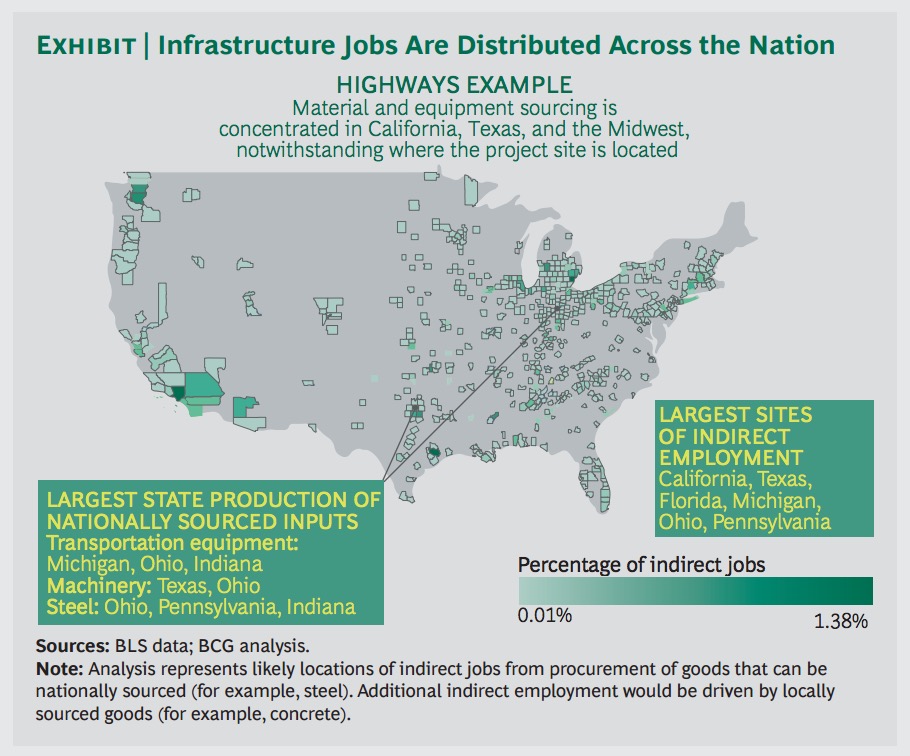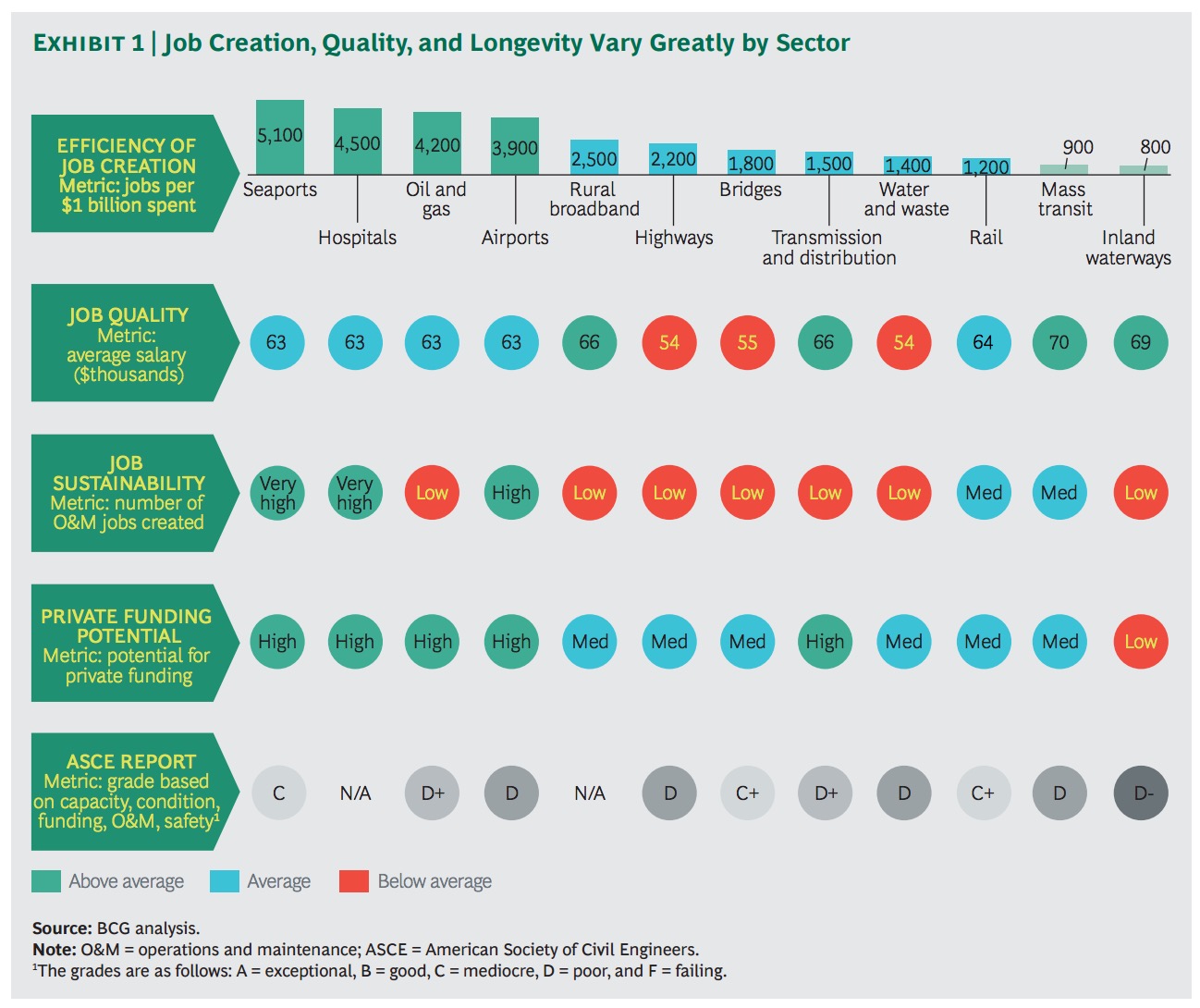THE BOSTON CONSULTING GROUP (BCG)
CG/LA INFRASTRUCTURE
At a Glance
The Trump administration has proposed investing an extra $1 trillion in infrastructure to create millions of new jobs. To maximize the impact of such investment on employment, planners need to adopt a new jobs-centric approach that prioritizes investments in infrastructure projects on the basis of their job creation potential.
Analyzing the Potential
The number, quality, and sustainability of jobs vary greatly across infrastructure sectors. Without a highly prioritized investment focus, $1 trillion in infrastructure spending could create as few as 1.6 million jobs. If government planners direct investments to projects on the basis of their job creation potential, however, the choices they make might help create 2.9 million or more incremental jobs.
Success Factors for Job Creation
To achieve their objectives, policy makers must position infrastructure as an engine of job creation and economic growth; create incentives for new projects in sectors (such as seaports, hospitals, and airports) that deliver high-quality or long-lasting jobs; fast-track projects to accelerate job creation; develop a scoring methodology to account for job creation impacts; make reporting on job creation a condition for funding; and track, monitor, and report job creation at the project and portfolio levels.
In his February 28, 2017, address to a joint session of Congress, President Trump asked the assembled lawmakers to pass legislation that would help underwrite a $1 trillion investment in US infrastructure, financed with capital from both public and private sources, with the goal of creating millions of new jobs. Investing to create robust US infrastructure has broad bipartisan political appeal, but surveys suggest that the public tends not to perceive it as a top priority. In an Ipsos poll conducted in October 2016, survey respondents ranked infrastructure as the tenth highest priority for the country. When infrastructure investment is positioned as an engine of job creation and a driver of the economy, however, it rises to the second or fourth highest priority These rankings suggest that government leaders must do a better job of communicating the connections between infrastructure spending, jobs, and economic growth if they are to gain broader support for infrastructure investments.
Creating millions of jobs will not be easy. If $1 trillion were invested over the fiveyear period from 2017 through 2021, the additional $200 billion in annual spending would represent an increase of more than 25% over current annual spending, which is approximately $700 billion. But at current ratios of GDP to employment, this investment would equate to roughly 1.6 million new jobs.2 A better goal would be to target something closer to an equivalent 25% increase in infrastructure-related employment by 2021, translating into the creation of 4 million new jobs and raising the overall total from 15.5 million (12% of total US jobs) to 19.5 million (14%). To achieve an increase of this magnitude, planners must systematically select the right projects to undertake.
Given how essential infrastructure is to the US economy, we believe that reframing the debate is critical. A solid grasp of today’s baseline is a crucial starting point. (See the sidebar “The Baseline for Infrastructure Job Creation.”) The ongoing impacts of automation and robotics on US employment underscore the importance of infrastructure investment to maintaining the country’s jobs and economic vigor. To ensure that the administration achieves or exceeds its job creation objectives, policy makers need to adopt a job-centric approach that prioritizes investments in infrastructure projects on the basis of their job creation potential, alongside project criticality.
To support this approach, BCG has developed a tool called the Infrastructure Jobs Scoreboard, which offers a comprehensive view of all infrastructure-related employment in the economy by job category, wage level, and location. (See the sidebar “Introducing the Infrastructure Jobs Scoreboard.”)
The Baseline for Infrastructure Job Creation
 Any systematic effort by the federal government to invest in infrastructure and capture the related benefits needs to be firmly grounded in an understanding of the nation’s infrastructure baseline:
Any systematic effort by the federal government to invest in infrastructure and capture the related benefits needs to be firmly grounded in an understanding of the nation’s infrastructure baseline:
- Today, US infrastructure investment is roughly 2.4% of GDP, versus a high of 3.0% in the 1960s—evidence that the country is not maintaining its critical infrastructure.
- The nation faces a $1.4 trillion infrastructure-funding gap through 2025. This shortfall roughly doubles when calculations take into account required operations and maintenance.
- Altogether, 15.5 million US jobs support infrastructure, making infrastructure one of the country’s top employment categories, representing 12% of national employment.
- Infrastructure jobs, on average, offer wages that are 28% higher than the national average for all types of jobs ($68,000 per year versus $53,000 per year) and provide employment to workers who need not have college degrees.
- Infrastructure jobs also provide employment opportunities across the nation. (See the exhibit to the left.)
Introducing the Infrastructure Jobs Scoreboard
BCG’s Infrastructure Jobs Scoreboard is a tool for visualizing the current distribution of US infrastructure jobs and the potential impact of additional infrastructure investment on those jobs. It captures direct jobs (which tend to be local) and indirect jobs (which may be distributed nationwide) on the basis of the sourcing of materials and equipment for a project. The tool enables users to identify where new jobs are likely to appear in connection with a project. The scoreboard provides four views:
- Overview: the total job creation impact and investment cost for the top shovel-ready projects by location, sector, and project
- New Jobs by Project: the number of jobs that could be created by funding specific infrastructure projects, with new jobs noted by type (design, construction, O&M, and project management) and by state or county
- New Jobs by Location and Sector: the number of jobs that could be created for a custom project as defined by location (county), sector, and total cost
- Existing Infrastructure Jobs: the number and type (direct or indirect) of existing infrastructure jobs, by state or county
BCG’s Infrastructure Jobs Scoreboard is accessible at infrajobs.bcg.com.
The Elements of a Jobs-Centric Approach
As yet, no infrastructure scoring system focuses primarily on job creation. Most systems base their scoring on multiple factors, such as economic growth, social welfare, and various externalities (including environmental impact). To be sure, due consideration of these factors is critical to any infrastructure investment approach. Nevertheless, in order to set strategic employment priorities effectively, decision makers need an additional framework. The appropriate model will focus not only on the volume of jobs created but also on their quality and economic sustainability over the long haul. The goal of the strategic planning should not be to create a large number of white elephant projects, but rather to create strong, vital, economically self-sustaining infrastructure.
A jobs-centric approach has four key elements:
- Focus on the creation of direct and indirect jobs. The emphasis is on jobs that can be estimated and counted accurately, rather than on approaches that involve gauging broader, “induced jobs” effects.
- Follow the money. Analysts must examine the division of project spending between labor and non-labor costs.
- Consider the geographic spread of jobs across the US. Success involves looking beyond the project site to the entire project supply chain.
- Drive accountability. The number of jobs must be estimated on the basis of common definitions and validated by the project owner; once the estimate is in place, the figures can be tracked over time to ensure that the projects are creating jobs as planned.
Planners can use this approach in conjunction with traditional approaches that take related factors into account. Some projects, such as those for national security or for maintenance and repair of crumbling assets, are critical and require action regardless of their job creation profile. But beyond those critical projects, taking a jobs-centric view will help attract broader support for an infrastructure agenda.
Download full version (PDF): A Jobs-Centric Approach to Infrastructure Investment
About the Boston Consulting Group (BCG)
www.bcg.com
The Boston Consulting Group (BCG) is a global management consulting firm and the world’s leading advisor on business strategy. We partner with clients from the private, public, and not-forprofit sectors in all regions to identify their highest-value opportunities, address their most critical challenges, and transform their enterprises. Our customized approach combines deep insight into the dynamics of companies and markets with close collaboration at all levels of the client organization. This ensures that our clients achieve sustainable competitive advantage, build more capable organizations, and secure lasting results. Founded in 1963, BCG is a private company with 85 offices in 48 countries.
About CG/LA Infrastructure
www.cg-la.com
CG/LA Infrastructure creates long-term value in the world’s infrastructure markets. It provides public and private sector organizations with services based on 25 years’ experience covering all infrastructure sectors in the developed and developing world. Core services include organizing an Infrastructure Leadership Forum series and providing advisory services. Together, these services form a dynamic package allowing stakeholders and decision makers to properly identify key market opportunities and challenges. CG/LA is headquartered in Washington, DC, and maintains offices in São Paulo, Brazil and Mexico City with affiliates and strategic partners that span the globe.
Tags: BCG, CG/LA Infrastructure, Infrastructure Investment, Job-centric approach, President Trump, The Boston Consulting Group, Trump Administration







 RSS Feed
RSS Feed